Rice is a staple in many homes. It is easy to cook and it pairs well with everything from beans to shrimp. Two of the more popular varieties of rice are brown rice and wild rice.
It’s not hard to pick out brown and wild rice. They look vastly different from white rice. Brown rice has a nice subtle brown color and wild rice is much darker in color, not to mention much longer in size.
Both types of rice are marketed as being healthier options than regular white rice. But how do these two kinds of rice compare to each other? Is one a healthier option than the other?
Rice is a regular menu item in my family so I want to see how these two kinds of rice compare to each other. As a working mom, I want food that is not only nutritious for my family, but also keeps us within our budget – and tastes good.

For this article, I will be comparing brown rice and wild rice side-by-side to see how they compare to each other. I will be examining everything from calories and fat content to flavor and texture.
There will be a winner at the end of each category but by the end of the article, you will have the information you need to decide which kind of rice is right for you and your family.
Ingredients Comparison
The first place I start any food comparison is with the ingredients. Unlike white rice which is often enriched with vitamins and minerals that are lost during the milling process, brown rice, and wild rice do not have any added ingredients.
Brown rice is a whole-grain food, meaning it retains two of its three layers during the milling process. The germ and bran layers in brown rice give it a higher fiber, vitamin, and mineral content than regular white rice.
Wild rice, on the other hand, is not even rice. It is a semi-aquatic grass that grows naturally in waterways all over North America. Yes, regular rice is also grown in water but wild rice is a true aquatic grass that has an edible grain.
Brown Rice vs. Wild Rice Nutritional Comparison
Even though brown rice is not technically rice, it is still a whole grain. Despite this difference, I want to see how these two kinds of rice compare nutritionally to each other.
Each comparison will have its own category and winner. Since the serving sizes for brown rice and wild rice differ, I am going to do a more accurate weight-for-weight comparison of 100g per serving for each one.
Best for Calorie Content
Calorie-wise, neither brown nor wild rice is very low. But if you are following a calorie-restricted diet or are simply calorie-conscious, wild rice is the right choice for you. Wild rice contains almost 10 calories less per serving than brown rice.
|
Rice Type |
Calories Per 100g Serving |
|
Brown Rice |
366 kcal |
|
Wild Rice |
357 kcal |
Best for Carbs & Sugar Content
Rice, in general, is not a low-carb food. The same is true of wild rice. There is not a big difference in the amount of carbs between these two, however, of the two, wild rice has fewer carbs per serving than brown rice.
|
Rice Type |
Carbs Per 100g Serving |
|
Brown Rice |
76.7g |
|
Wild Rice |
74.9g |
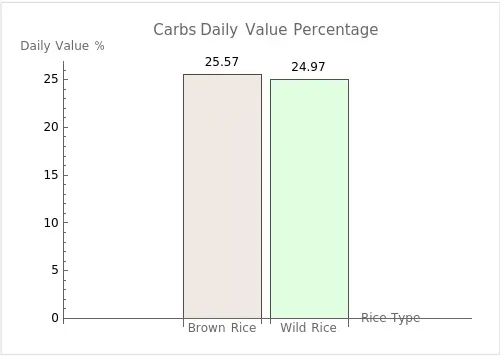
The recommended daily intake for carbohydrates on a 2,000 calorie diet is 300g.
Brown rice and wild rice are both sugar-free but that does not mean they are safe for just anyone to eat. Both brown rice and wild rice are very high in starch content. Starch is a complex carb made of sugar molecules.
Complex carbs take longer for the body to break down, which means they take longer to digest and have a slower effect on your blood sugar, causing it to rise more slowly.
If you have diabetes or high blood sugar, you are more sensitive to blood sugar spikes. Wild rice is the healthier option for you but it is best for you to consult your doctor or nutritionist before adding this food to your diet.
Best for Protein Content
Eating a diet high in protein is nothing new to us moms. We are constantly reminded of the need to make sure our little ones are getting enough protein for the development of their bones and muscles.
But in reality, protein is essential for all of us. Protein helps us recover from injury and illness, it helps lower your blood pressure, keeps our muscles and bones strong as we age, and it has numerous benefits for our waistline.
For this category, the winner is obvious – wild rice. Wild rice contains almost 15g of protein, double the amount of protein found in brown rice.
|
Rice Type |
Protein Per 100g Serving |
|
Brown Rice |
7.25g |
|
Wild Rice |
14.7g |
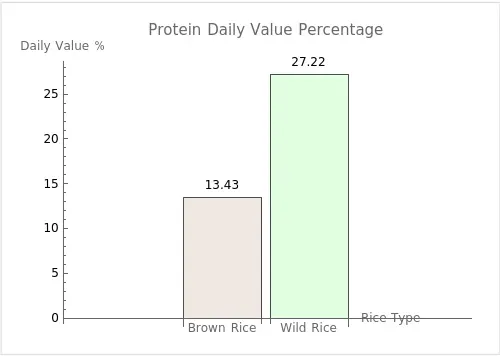
The recommended daily protein intake can vary based on factors such as age, gender, and activity level. However, a general guideline suggests that the average sedentary adult requires about 0.8 grams of protein per kilogram of body weight. For an average adult weighing 68 kilograms (150 pounds), this translates to about 54 grams of protein per day.
Given the protein content as mentioned:
- Brown Rice: 7.25g of protein per 100g serving
- Wild Rice: 14.7g of protein per 100g serving
Using the general guideline of 54 grams as the recommended daily protein intake, we can calculate the daily value percentage for each type of rice:
- Brown Rice: 7.25/54 × 100 = 13.43
- Wild Rice: 14.7/54 × 100 = 27.22%
Best for Fat Content
When it comes to fat content, both brown rice and wild rice are great options but, here again, wild rice is the better option of the two. A serving of wild rice has only 1 g of fat but brown rice has over 3 grams.
|
Rice Type |
Fat Content Per 100g Serving |
|
Brown Rice |
3.31g |
|
Wild Rice |
1.08g |
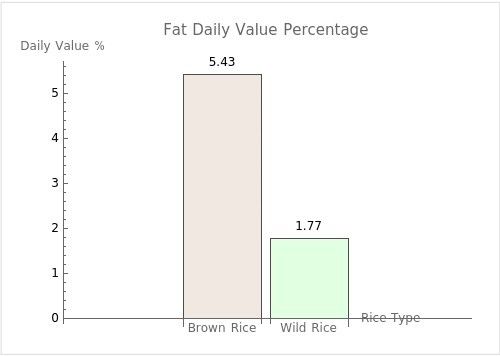
The recommended daily fat intake for an average adult on a 2,000 calorie diet is approximately 44 to 78 grams, with an average of 61 grams. As depicted in the graph
The recommended daily fat intake should be between 20% to 35% of total daily calories. For a 2,000 calorie diet, this translates to about 44 to 78 grams of fat per day, with an average of 61 grams.
Given the fat content as noted above:
- Brown Rice: 3.31g of fat per 100g serving
- Wild Rice: 1.08g of fat per 100g serving
Using the average guideline of 61 grams (the midpoint between 44 and 78 grams) as the recommended daily fat intake, we can calculate the daily value percentage for each type of rice:
- Brown Rice: 3.31/61 x 100 = 5.43%
- Wild Rice: 1.08/61 × 100=1.77%
- Brown Rice: 5.43% of the recommended daily intake
- Wild Rice: 1.77% of the recommended daily intake
Best for Sodium/Salt Content
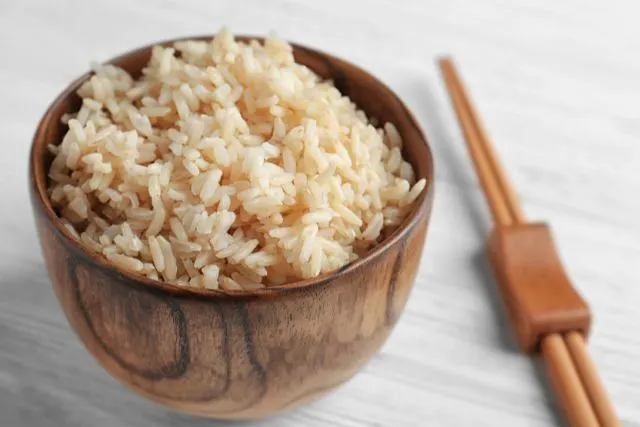
Both brown rice and wild rice have naturally occurring salt content. The amount is low but it should be kept in mind when you are preparing rice.
If you add salt to the water as you are boiling the rice or pair the rice with a protein that has sodium added to it, this will alter the final amount of sodium in your rice dish.
According to the USDA website, a 100g serving of brown rice has 2.5mg of sodium, and wild rice has 7mg.
|
Rice Type |
Sodium Content Per 100g Serving |
|
Brown Rice |
2.5 mg |
|
Wild Rice |
7mg |
Best for Vitamins/Minerals
Brown rice and wild rice are both full of essential vitamins and minerals, but wild rice contains higher amounts of each vitamin and mineral. Wild rice has higher amounts of calcium, zinc, and potassium, just to mention a few.
The table below gives a brief breakdown of the vitamins and minerals found in brown rice and wild rice. You can find a more extensive list on the USDA website.
|
Vitamin/Mineral |
Brown Rice (Per 100g) |
Wild Rice (Per 100g) |
|
Calcium |
8mg |
21mg |
|
Phosphorus |
303mg |
433 mg |
|
Zinc |
1.85mg |
5.96mg |
|
Iron |
1.24mg |
1.96mg |
|
Potassium |
250mg |
427mg |
|
Magnesium |
115mg |
177 mg |
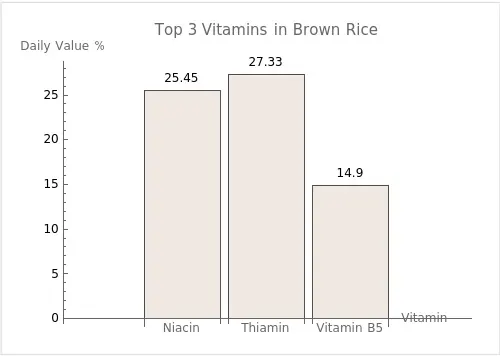
- Niacin (Vitamin B3):
- Recommended Daily Intake: 20 mg/d (milligrams per day)
- Brown Rice Content (from the article): 5.09 mg per 100g serving
- Daily Value Percentage: 5.09/20 × 100 = 25.45%
- Thiamin (Vitamin B1):
- Recommended Daily Intake: 1.5 mg/d (milligrams per day)
- Brown Rice Content (from the article): 0.41 mg per 100g serving
- Daily Value Percentage: 0.41/1.5 × 100 = 27.33
- Vitamin B5 (Pantothenic Acid):
- Recommended Daily Intake: 10 mg/d (milligrams per day)
- Brown Rice Content (from the article): 1.49 mg per 100g serving
- Daily Value Percentage: 1.49/10 × 100 = 14.9%
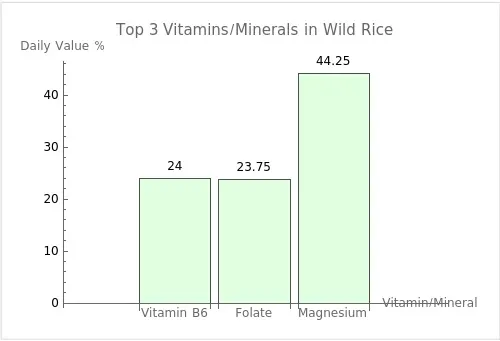
- Vitamin B6:
- Recommended Daily Intake: 2 mg/d (milligrams per day)
- Wild Rice Content (from the article): 0.48 mg per 100g serving
- Daily Value Percentage: 0.48/2 × 100 = 24%
- Folate:
- Recommended Daily Intake: 400 μg/d (micrograms per day)
- Wild Rice Content (from the article): 95 μg per 100g serving
- Daily Value Percentage: 95/400 × 100 = 23.75%
- Magnesium:
- Recommended Daily Intake: 400 mg/d (milligrams per day)
- Wild Rice Content (from the article): 177 mg per 100g serving
- Daily Value Percentage: 177/400 × 100 = 44.25%
Best for Flavor/Texture
Brown rice and wild rice are very similar when it comes to flavor. Both have a slight nutty flavor. My family does not find the flavor to be overpowering but you will have to be the judge for yourself and your family.
The slightly nutty flavor of brown rice makes it a nice complement to any protein or vegetable. One of my family’s favorite dishes is using brown rice to make fried rice.
I add slightly sauteed vegetables such as broccoli, carrots, and onion and stir-fry them with the rice. I like to add two scrambled eggs to increase the protein and it helps make the rice feel more like take-out than homemade.
Texture-wise, these two kinds of rice do differ. Brown rice has a soft texture that can often be mushy if overcooked. Wild rice, on the other hand, has a nice chew to it.
The texture of wild rice is a nice complement to softer foods. I like to pair wild rice with fish or salmon. I find the slight texture of wild rice to be a nice contrast with the softer texture of fish.
Best for Price
Deciding which rice is best for the price will depend on where you live. In my town, the price for brown rice and wild rice does not vary greatly. I find it helpful to look online at the stores around me to find the best price.
Both brown rice and wild rice can easily be found in any grocery store but you can find a wider variety in the natural health food stores. You will pay more for both kinds of rice, but you will also be getting rice that is organic.
Overall Winner
This comparison revealed that both brown rice and wild rice are good options when it comes to choosing a healthy rice. Both types of rice are low in fat, high in protein, and have many healthy vitamins and minerals.
But there can only be one winner – wild rice. Wild rice has fewer calories, twice the amount of protein, and half the amount of fat as brown rice. It also has higher amounts of calcium, phosphorus, zinc, potassium, and magnesium.
Comparison Category |
Brown Rice vs. Wild Rice |
|
Best for Calorie Content |
Wild Rice |
|
Best for Carbohydrate Content |
Wild Rice |
|
Best for Sugar Content |
Wild Rice |
|
Best for Protein Content |
Wild Rice |
|
Best for Fat |
Wild Rice |
|
Best for Sodium/Salt |
Brown Rice |
|
Best for Vitamins/Minerals |
Wild Rice |
|
Best for Price |
Both are winners |
Overall Winner |
Wild Rice |
